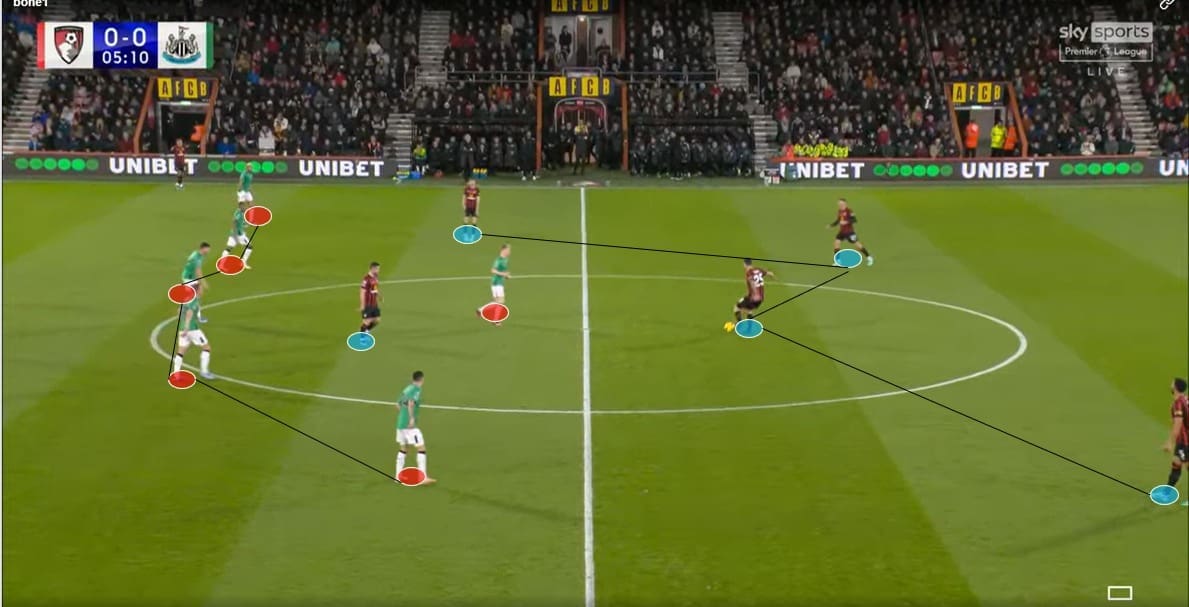As Newcastle United geared up for the upcoming match against AFC Bournemouth, their recent performances showcased a mix of highs and lows, tallying two victories, two losses, and a draw in the last five games. This inconsistent form prompted reflections on how Newcastle is navigating through injury challenges and scrutinized manager Eddie Howe’s adjustments to game plans. In this article, we delve into the intricacies of Newcastle United’s form, shedding light on the questions surrounding their approach to injuries and the strategic choices made under Howe’s leadership.
What culminated though was Andoni Iraola‘s Bournemouth taking advantage to make inroads from the bottom 3 and climb the table with a 2-0 result. While AFC Bournemouth rightly deserve praise for the win, was Howe’s gameplan to blame?? And how did Iraola made the best out of it tactically?? Let’s dive in.
Newcastle In and Out of Possession
Are the Magpies too vulnerable to cutbacks



Pics 1, 2, 3: Newcastle sliced upon by a fine sequence worked by Bournemouth to generate a chance inside box
In the initial moments of the game, Newcastle appeared to lack pace, affirming a recurring pattern observed in which they frequently concede opportunities from cutbacks. As illustrated in the series of images in Pic1, 2, and 3, Bournemouth effectively stretched Newcastle’s four-man defense, exploiting the gaps between center-backs and full-backs.
That meant Bournemouth regularly had the opportunity to have their midfielders make late runs into the box without trackers, a responsibility usually undertaken by Bruno Guimaraes or Joelinton. Throughout the game, Iraola, utilizing Bournemouth’s 4-2-4 formation, effectively capitalized on this strategy, while Howe appeared to provide limited tactical adjustments in response.
Bournemouth’s Transitional Game
Best Game Plan Response from Iraola??

Pics 4: Newcastle’s 4-5-1 shape against Bournemouth
Bournemouth countered well against Newcastle’s 4-5-1 who perhaps were baited well in 1st phase by using a 4-1 setup. This ensured that by spreading the play, gaps between the 5 man line could be found. Once again Howe’s judgement here could be questioned because of the fact that though a 4-5-1 offers 2 sets of wide men and 3 midfielders to prevent central penetration, Bournemouth were able to work out some better 3rd man combinations that helped them beat Newcastle’s rather Passive press.
Vid 1: Bournemouth’s 1st goal against Newcastle
Bournemouth kept pressurizing and eventually, Newcastle couldn’t really keep up after a lot of shots kept away by Nick Pope. A critical mistake, coupled with Solanke’s astute positioning, allowed Bournemouth to capitalize on the error and successfully find the net near Pope’s post. The unfolding of this play underscored a pre-existing vulnerability in Newcastle’s defensive approach, particularly in their susceptibility to cutbacks or, in simpler terms, leaving spaces in the middle during the final phase of the opponent’s attacks.
Perhaps the best mention should go to Solanke, who despite being deemed quiet throughout the game kept composure to make the right run and finish the chance. It’s very noticeable how Iraola wants his runners inside the box, especially if you note towards 0:11 in Vid 1 where far post runners had easy tap-ins if the ball was squared, an aspect of Iraola’s Rayo we finally see pay dividends in an important game.

And as the tagline for the sub-heading suggested, despite larger possession from Newcastle, AFC Bournemouth generated an incredible 2.51 xG to outshoot Newcastle’s mere 0.49, and perhaps served as proof that the Cherries can continue playing the swift transition game with Iraola and get results. The pass network also shows their left tilt that worked very well in generating the aforementioned cutback chances we discussed against Newcastle.
The key passes viz in the bottom left pitch show the same: Cutback one after another while all Newcastle managed were few long-range efforts that didn’t really test the better of Neto.
Conclusion
The significance of this game before the international break is heightened due to Bournemouth’s challenging campaign, one that has frequently tested the resolve of the club’s leadership to evaluate Iraola’s future. Despite maintaining the stance that this is a long-term project worthy of investment, the persistent trials faced by Bournemouth underscore the critical juncture at which the club finds itself.
As for Eddie Howe, the injury crisis is something that’s slowly exposing the flaws this Newcastle team still has despite the larger makeovers they have undergone under the PIF ownership. While Howe’s still the best man to lead the project, this game probably strengthens the point that they need to upgrade a lot of profiles to continue fighting on multiple fronts across various competitions.

